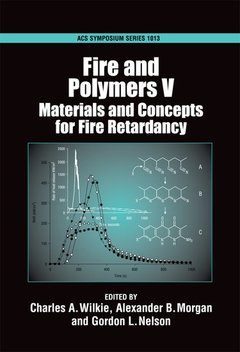Fire and Polymers Materials and Concepts for Fire Retardancy An American Chemical Society Publication Series, Vol. 1013
Langue : Anglais
Coordonnateurs : Wilkie Charles A, Nelson Gordon L, Morgan Alexander B

Fire is a continuing problem around the world and it must be controlled. This ACS Symposium Series volume addresses recent advances in fire retardancy and examines progress that has been made in controlling fires. It focuses on the chemistry of the polymers themselves and how those chemical structures yield particular heat release, thermal decomposition products, and full-scale fire performance. The book consists of 5 sections. First, the Editors produce an overview to put the latest research into perspective. The first third of the book focuses on Nanocomposites and Flame Retardancy and represents the current state of the field. The second third of the book is devoted to Polymer Flammability Measurement and Mechanisms. The remainder of the book will is equally divided between New Flame Retardant Chemistry and Recent Developments in Flame Retardant Materials. Each of the 4 technical sections is preceded by a short overview provided by the editors.
1. Fire retardancy in 2008. Composites and Nanocomposites. 2. Thermal evolution of Nanocomposites and Fire Testing Performance. 3. Functionalized-carbon multiwall nanotube as flame retardant for polylactic acid. 4. Use of Layered Double Hydroxides as Polymer Fire Retardant Additives: Advantages and Challenges. 5. Effect of Flame Retardants on the Thermal, Burning and Char Formation Behaviour of Polypropylene. 6. Flammability of Polymer/Inorganic Nanocomposites. 7. Flame retardant PET/PC blends compatibilized by organomodified Montmorillonites. 8. Development of Polyurea Nanocomposites with Improved Fire Retardancy. 9. Fire Retardant Mechanism of Acrylonitrile Copolymers Containing Nanoclay. 10. Fire and Engineering Properties of Polyimide-Aerogel Hybrid Foam Composites for Advanced Applications. 11. Advanced Flame-retardant Epoxy Resins for Composite Materials. Conventional Fire Retardants. 12. Fire Retardancy of Polypropylene Composites using Intumescent Coatings. 13. Combustion and thermal properties of polylactide with an effective phosphate-containing flame retardant oligomer. 14. Effects of boric acid on flame retardancy of IFR polypropylene system containing a caged bicyclic phosphate. 15. Brominated aryl phospholane flame retardants. 16. Development of multifuntional flame retardants for polymeric systems. 17. Flammability of Fluoropolymers. 18. Up-Cycling of Rubber-Plastic Waste to Fire Retarded System. Metal-Containing Systems. 19. A Review of Transition Metal-Based Flame Retardants Transition Metal Oxide/Salts, and Complexes. 20. Salen Copper Complexes: A Novel Flame Retardant for Thermoplastic Polyurethane. Toxicity. 21. Effects of Fire Retardants and Nanofillers on the Fire Toxicity. Thermal Degradation Studies. 22. Modelling Thermal Degradation of Flame-retarded Epoxy Resin Formulations under Different Heating Conditions. 23. Effect of Ambient Oxygen Concentration on Thermal Decomposition of Polyurethanes Based on MDI and PMDI.
Charles A. Wilkie has worked in the area of fire retardancy for the past 30 years. His primary interest for the past 10 years has been in the utility of polymer-clay nanocomposites in fire retardancy. Gordon L. Nelson is the Dean of the College of Science and the Liberal Arts and Professor of Chemistry at Florida Institute of Technology. Alex Morgan is currently working on a variety of projects where flammability performance is a key factor, and is the contact person for the UDRI fire testing and research capabilities. He is also in charge of the Polumeric Materials Characterization Lab (PMCL) where he coordinates internal and external research on polymeric material analysis.
Date de parution : 07-2009
Ouvrage de 456 p.
16x23.7 cm
© 2024 LAVOISIER S.A.S.
